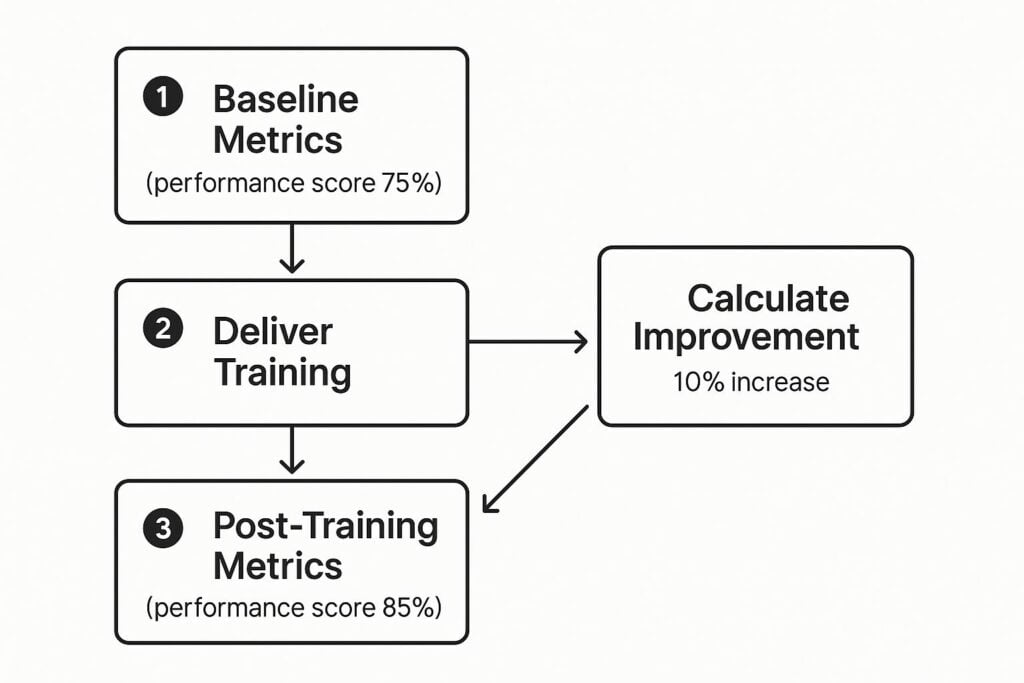Proving the Value of Your ROI on Training

Calculating the ROI on training isn’t just about spreadsheets and formulas. It’s about proving the direct financial return your employee development programs generate for the business.
When you can show a positive ROI, you’re no longer talking about an expense. You’re talking about a measurable investment that turns learning into profit.
Why Measuring ROI on Training Is a Game Changer
Let’s be honest. For too long, training has been treated as a necessary cost you just have to absorb, with benefits that feel vague and hard to pin down. But what if you could prove its exact, bottom-line value to your business?
That’s where measuring the ROI of training comes in. It’s one of the most powerful moves you can make because it flips the script entirely. It turns your program from a simple line item in the budget into a strategic investment that drives real, tangible growth.
This is all about drawing a straight, undeniable line from every dollar spent on employee development directly to your company’s most important goals.
Shifting from Expense to Investment
I’ve seen it time and time again. Companies treat training as a “check-the-box” activity. But the moment you start tracking the return, the entire conversation changes. Instead of asking, “How much does this cost?” leaders start asking, “How much can we grow?”
Suddenly, a sales training program isn’t just a budget item. It’s the reason your team is closing 15% larger deals. A project management workshop becomes the key to shaving a week off project timelines, saving thousands in operational costs.
The core idea is simple: connect learning outcomes to business outcomes. When you nail that, you stop justifying costs and start demonstrating undeniable value.
This shift in perspective is absolutely crucial, especially when budgets get tight. When you have the data to back up your claims, getting funding for employee development becomes a much easier conversation.
Staying Ahead of the Skills Gap
The pressure to deliver effective training has never been higher. A recent study from McKinsey & Company found that a staggering 87% of firms worldwide are already facing or expect to face a significant skills gap. This isn’t a future problem. It’s happening right now, pushing organizations to get serious about upskilling their teams. You can learn more about how to measure the impact of skill development on bundleskills.com.
Measuring the ROI on your training helps you tackle this challenge head-on by letting you:
- Prioritize with confidence: You can pinpoint which programs deliver the highest return and funnel your resources where they’ll make the biggest impact.
- Secure buy-in: Hard data is the ultimate proof. It gives stakeholders and executives the evidence they need to support and fund future training initiatives.
- Improve continuously: By analyzing what’s working and what isn’t, you can systematically refine your programs to become even more effective over time.
You can’t afford to guess about your training’s impact anymore. By measuring its ROI, you gain the clarity needed to build a smarter, more skilled, and more competitive workforce.
Identifying the Key Costs and Benefits

Alright, now that we’re on the same page about why measuring training ROI is so critical, let’s get our hands dirty. To figure out the return on your investment, you need a crystal-clear picture of both sides of the equation: what you spent (the costs) and what you got back (the benefits).
Think of it like assembling a puzzle. Before you can see the whole picture, you need to gather all the individual pieces. That’s exactly what this part is all about.
Uncovering the Full Spectrum of Training Benefits
When people think about training benefits, their minds usually jump straight to the obvious wins, like a sales team closing more deals after a negotiation workshop. These tangible results are fantastic because you can easily put a dollar sign next to them. But they’re only half the story.
The “softer” benefits, while trickier to measure, are often just as valuable. These are the gains that quietly strengthen your company culture, boost employee morale, and improve long-term stability. If you ignore them, you’re missing a massive chunk of your ROI on training.
Here are some of the key benefits you should be looking for:
- Increased Productivity: Are teams hitting deadlines faster? Is the output per employee on the rise? This is a direct, bottom-line win.
- Improved Quality of Work: You might see this as a drop in production errors, fewer bugs in the code, or a noticeable decrease in customer complaints.
- Higher Employee Retention: Happy, skilled employees don’t look for the exit. A study by the Work Institute found that lack of career development is a top reason people quit, and we all know how expensive turnover is.
- Enhanced Employee Engagement: When you invest in your people’s growth, they invest back in you with more motivation and commitment. It’s a powerful cycle.
Don’t just look for immediate financial gains. Some of the most significant returns from training, like a stronger company culture and reduced employee turnover, build up over time and create lasting value.
To get this right, you have to know what success looks like before the training even starts. Running a thorough needs analysis is non-negotiable, because it pinpoints the exact skills gaps you’re trying to close. If you’re not sure where to begin, our guide to using a training needs assessment template can provide a solid framework.
To really nail this down, it helps to separate the tangible from the intangible. Here’s a quick breakdown of metrics you should be tracking both before and after any training initiative.
Key Metrics for Measuring Training Impact
| Metric Category | Specific Metric to Track | How to Measure It |
|---|---|---|
| Productivity & Efficiency | Time to complete specific tasks | Time tracking software, project management data |
| Productivity & Efficiency | Output volume (e.g., units produced, calls handled) | Production reports, call center analytics |
| Quality & Accuracy | Error rates or defect numbers | Quality assurance (QA) reports, customer feedback |
| Quality & Accuracy | Customer satisfaction scores (CSAT, NPS) | Pre- and post-training surveys |
| Financial Outcomes | Sales revenue or conversion rates | CRM data, sales performance dashboards |
| Financial Outcomes | Cost savings from improved processes | Operational expense reports |
| Employee Engagement | Employee engagement survey scores | HR platform surveys (e.g., Culture Amp, Peakon) |
| Employee Engagement | Voluntary turnover/retention rates | HRIS data, exit interview feedback |
Tracking these metrics gives you concrete data points to build your ROI case. It makes it much easier to show the true, holistic impact of your programs.
Accounting for Every Single Cost
Now, let’s flip to the other side of the coin: the costs. This is where people consistently underestimate the true investment. The price tag on the course itself is just the tip of the iceberg.
To get an accurate calculation, you have to hunt down every direct and indirect expense tied to the program. If you leave costs out, you’ll end up with an inflated, misleading ROI figure that won’t hold up under scrutiny.
Direct and Indirect Training Costs
Direct costs are the straightforward, upfront expenses you can easily pull from invoices and budget reports.
- Instructor or Vendor Fees: What you paid the external trainer or the platform providing the course.
- Training Materials: Any workbooks, software licenses, or physical tools required for the training.
- Venue and Travel: For in-person sessions, this includes room rental, flights, hotels, and meals.
Indirect costs are a bit sneakier but just as real. They represent the internal resources and time that don’t show up on an invoice but still carry a significant business cost.
- Employee Time: This is the big one. Every hour an employee spends in training is an hour they aren’t doing their primary job. You have to calculate the cost of their wages for the duration of the training.
- Administrative Time: Don’t forget the hours your HR or L&D team poured into organizing, scheduling, and managing the entire program.
- Productivity Dip: It’s common to see a temporary drop in output right after training as employees get the hang of new tools or workflows. This is a real, albeit short-term, cost.
By building a complete inventory of both your benefits and your costs, you’re setting a rock-solid foundation. You’ll have all the necessary components to calculate an accurate and meaningful ROI on training that truly reflects the program’s impact on your business.
Calculating Your Training ROI Step by Step
Alright, this is where the rubber meets the road. We’ve talked about why measuring ROI is important and what to track, but now it’s time to actually crunch the numbers. I want to walk you through the calculation using a practical, real-world scenario. This will make it feel less like a math problem and more like a story you can follow and apply to your own programs.
Let’s imagine a sales team of 20 people just wrapped up a two-day workshop on advanced negotiation skills. Our goal is to figure out if that workshop was a smart investment. To do this, we’ll tally up all the costs, pinpoint the financial benefits, and plug those numbers into the classic ROI formula.
Breaking Down the ROI Formula
The standard formula for calculating training ROI is beautifully simple. Don’t let the terms intimidate you. It’s just a way to compare what you got back to what you put in.
Here it is:
Training ROI (%) = [(Net Program Benefits – Total Program Costs) / Total Program Costs] x 100
Let’s quickly break down what each piece means:
- Total Program Costs: This is every single penny you spent on the training. We’ll get into the nitty-gritty of this in a moment.
- Net Program Benefits: This is the monetary value of the improvements you saw after subtracting the costs. Think of it as the “profit” from your training investment.
Once you have these two numbers, the rest is just simple math. The result is a clear percentage that tells you the return you got for every dollar invested.
Tallying Up the Total Training Costs
First things first, we need a complete picture of the total investment. For our sales team’s negotiation workshop, let’s map out all the costs involved.
Here are the direct, obvious expenses:
- Trainer’s Fee: The expert consultant charged $10,000 for the two-day session.
- Training Materials: Workbooks and handouts cost $50 per employee, for a total of $1,000 (20 employees x $50).
- Venue & Catering: The off-site meeting room and lunches came to $2,500.
Those direct costs add up to $13,500. But here’s where many people stop, and it’s a huge mistake. We can’t forget the indirect costs, the cost of pulling people away from their jobs.
- Employee Wages: The 20 salespeople were in training for two full 8-hour days. If their average hourly wage is $35, the cost of their time is $11,200 (20 employees x 16 hours x $35/hour).
Now we can get our true total cost.
Total Program Costs = $13,500 (Direct) + $11,200 (Indirect) = $24,700
This number, $24,700, is the “Total Program Costs” piece of our formula. It’s the total investment we need to get a return on.
Pinpointing the Financial Benefits
This next part requires a bit more digging, but it’s where you see the real magic happen. We need to find a metric that the negotiation training would directly influence. For a sales team, two of the best metrics are their deal-closing rate and the average size of the deals they close.
Let’s say we were smart and tracked their performance for three months before the training and for three months after.
Here’s what we found:
- Before Training: The team’s average close rate was 20%, and their average deal size was $8,000.
- After Training: The team’s average close rate jumped to 25%, and their average deal size increased to $9,000.
That’s a fantastic improvement. Now, let’s turn that into a dollar amount.
Assuming the team collectively works on 400 qualified leads in a three-month period, we can calculate the revenue impact.
- Revenue Before Training: 400 leads x 20% close rate x $8,000/deal = $640,000
- Revenue After Training: 400 leads x 25% close rate x $9,000/deal = $900,000
The total increase in revenue over those three months is a whopping $260,000 ($900,000 – $640,000). But revenue isn’t profit. To get our “Net Program Benefits,” we need to factor in the profit margin. If the company’s profit margin on these deals is 40%, the actual profit generated from this increase is $104,000 ($260,000 x 0.40).
This is the core of the measurement process, capturing pre- and post-training data to quantify the improvement.

By tracking a baseline and comparing it to post-training results, we can isolate the specific lift that the training delivered. It’s all about connecting the dots with data.
Putting It All Together for the Final Calculation
We have all our numbers. Now we just need to plug them into the formula we started with.
- Net Program Benefits: $104,000
- Total Program Costs: $24,700
Let’s do the math:
- Subtract Costs from Benefits: $104,000 – $24,700 = $79,300
- Divide by Costs: $79,300 / $24,700 = 3.21
- Multiply by 100: 3.21 x 100 = 321%
The final ROI on this sales negotiation training is a massive 321%.
This means that for every single dollar the company invested in this training program, it got back $3.21 in profit. That’s a number that gets attention. It proves the training was a powerful engine for business growth, not just a “nice-to-have” expense.
By following this process, you can confidently calculate the ROI on training for your own programs and build an undeniable business case for their value.
What Successful Training ROI Looks Like
Formulas and calculations are great, but nothing makes the value of training click quite like seeing it in action. Let’s move past the theory and look at some powerful examples of what a successful ROI on training actually looks like in the real world.
These stories show a straight line from a specific training program directly to a measurable business outcome. Time and again, this proves that a smart investment in your team is one of the most reliable ways to grow your bottom line.
Slashing Development Cycles in Tech
I once worked with a fast-growing tech company that was constantly tangled up in missed deadlines. Their software development lifecycle was bloated, and projects were consistently running over schedule, costing them dearly in both time and money.
They decided to invest in a comprehensive Agile project management course for their entire development and product teams. The goal was crystal clear: streamline their workflow and get products to market faster.
The results were incredible.
- Before Training: Their average development cycle for a new feature was a sluggish 75 days.
- After Training: Within six months, they had sliced that average down to just 45 days.
This 40% reduction in their development timeline created a massive ripple effect. They could release updates more frequently, respond to customer feedback quicker, and ultimately gain a major competitive edge. The ROI here wasn’t just a number. It was a fundamental shift in their operational heartbeat.
Boosting Customer Satisfaction Scores
Another great example comes from a customer service team at a B2B software company. They were dealing with decent but stagnant customer satisfaction (CSAT) scores that hovered around 65%. They knew they could do better.
The company rolled out a new communication and empathy training program focused on active listening and problem-solving. This was a soft skills investment which can sometimes feel harder to measure. But they were diligent about tracking the impact.
Within three months of completing the training, their average CSAT score soared to 85%. That’s a nearly 30% increase. This improvement led directly to higher customer retention and even an uptick in upsells, as happier clients were far more willing to expand their contracts.
A strong ROI on training often extends far beyond the initial financial gain. In this case, not only did profits increase, but employee morale on the service team skyrocketed. They felt more equipped and confident in their roles, which reduced team turnover.
The evidence for this connection is compelling. Research from the Association for Talent Development shows that companies offering comprehensive training programs see a 218% higher income per employee and a 24% higher profit margin compared to those that don’t invest in their people.
Cultivating a Stronger, More Engaged Culture
Beyond the hard metrics, successful training ROI creates a more resilient and engaged workforce. When employees see you’re investing in their growth, they become more invested in the company’s success. This is where you see those amazing secondary benefits kick in.
- Higher Employee Retention: People are much less likely to leave when they feel valued and see a clear path for career growth within the company.
- Improved Innovation: A well-trained team is better equipped to solve problems creatively and bring fresh ideas to the table.
- Stronger Internal Mobility: Upskilling your current employees is almost always more cost-effective than hiring externally.
By diligently tracking the right metrics and focusing on impactful programs, it’s possible to see massive returns. Many organizations are even achieving 100% ROI on their training initiatives.
Making your training programs more engaging is a key part of maximizing these returns. Incorporating elements of play and competition can significantly boost knowledge retention. For fresh ideas on how to do this, check out our guide on using gamification for training to make learning more effective and enjoyable.
Ultimately, a successful ROI on training is about creating a positive feedback loop. You invest in your people, they perform better, the business grows, and you can invest even more in their development. It’s a powerful cycle that builds a stronger, more capable organization from the inside out.
Practical Ways to Maximize Your Training ROI

Getting a positive ROI on training is a great start, but the real goal is to make that return exceptional. You want to move from “good enough” to truly outstanding results that make a noticeable difference in your business.
This isn’t about throwing more money at the problem. It’s about being more strategic with every dollar you invest to create lasting change and a stronger, more capable team. These are the strategies I’ve seen separate average training programs from the ones that genuinely drive growth.
Set Crystal-Clear Objectives from Day One
Before you even think about choosing a program, you have to know exactly what you want to achieve. Vague goals like “improve communication” are a recipe for a disappointing ROI.
You need to get specific. A much better goal would be, “reduce inter-departmental project delays by 15% in the next quarter by training team leads in a specific project management framework.” See the difference? One is a wish, the other is a measurable business objective.
When you start with a clear target, you can design or select a training program that directly addresses that specific need. This focused approach is the foundation for a high ROI on training.
Make Sure the Learning Doesn’t End with the Class
One of the biggest mistakes I see is assuming the learning is done once the workshop is over. The reality is that without reinforcement, most new information is forgotten within weeks. This is where post-training support becomes a game-changer.
Simply putting people through a course and hoping for the best is a wasted investment. The real value is unlocked when new skills are actively practiced, supported, and integrated into daily work.
You can supercharge knowledge retention with a few key tactics:
- Mentorship Programs: Pair employees who completed the training with experienced mentors who can help them apply new skills in real-world scenarios.
- Follow-Up Sessions: Schedule short check-in meetings a few weeks after the training to discuss challenges, celebrate wins, and answer questions.
- Resource Hubs: Create a simple online space with key takeaways, videos, and quick reference guides that employees can access anytime they need a refresher.
Implementing effective training delivery methods is also crucial. For instance, well-designed video modules can be a practical way to provide ongoing support. For tips on making them effective, you might find this guide to Create Video Training That Actually Sells helpful.
Get Managers Actively Involved
Your managers are the single most important factor in ensuring training sticks. If they don’t support and champion the new skills, your team will quickly revert to their old habits.
Managers need to be brought into the process from the very beginning. They should understand the training’s goals, be equipped to coach their team members, and be responsible for holding them accountable for applying what they’ve learned.
When managers actively reinforce the training, it sends a powerful message that this isn’t just a one-off event. It’s a new standard for how work gets done. You can manage and track all these moving parts more easily by leveraging the right tools. Our guide on training management software explores options that can help streamline this process.
Align Every Initiative with Broader Company Goals
Finally, every training program should directly support a larger strategic goal for the company. A standalone leadership workshop might feel good, but a leadership workshop designed to support the company’s expansion into a new market is far more powerful.
This alignment ensures your training budget is always working in service of the company’s biggest priorities. A global survey highlighted that firms offering training to engaged employees are 17% more productive and realize 21% higher profits than their competitors. These companies also earn over double the income per employee and enjoy a 24% greater profit margin. You can discover more insights about these employee training statistics on intellum.com.
By being intentional about your objectives, providing ongoing support, and ensuring manager buy-in, you can dramatically increase your training ROI and build a more skilled, engaged, and effective workforce.
Answering Your Top Questions About Training ROI
Whenever I dig into the nuts and bolts of calculating training ROI, a few key questions always surface. It’s completely normal, especially when you’re first trying to draw a clear line between what happens in a training session and what happens on the company’s bottom line.
I’ve rounded up the most common ones I hear. My goal is to give you some straightforward, experience-based answers to help you move forward with more confidence.
How Can I Measure the ROI of Soft Skills Training?
This is the big one. It’s probably the number one question I get, and for good reason. Trying to measure the impact of skills like communication, leadership, or teamwork can feel like trying to nail Jell-O to a wall. You can’t just point to a sales chart.
But it’s absolutely doable. You just have to shift your focus.
The trick is to connect that soft skill to a measurable business problem. Before you even launch the training, you need to identify a key performance indicator (KPI) that you expect the new skill to influence.
Let’s say you’re rolling out a new leadership development program. Instead of trying to measure “leadership,” you could track:
- Team retention rates: Great leaders don’t just manage, they inspire loyalty. Track the voluntary turnover on their teams before and after the training. Lower turnover has a direct, calculable financial benefit.
- Employee engagement scores: Use your regular pulse surveys to see if morale and engagement are climbing on those leaders’ teams. Higher engagement is strongly linked to higher productivity.
- Project completion rates: Effective leadership slices through delays and roadblocks. Are projects led by these trained managers finishing on time and on budget more consistently?
By zeroing in on these business metrics, you can start to isolate the financial impact of improved soft skills, just like we did with the more straightforward sales training example.
The secret is measuring the tangible business outcome that the soft skill is meant to improve, not the soft skill itself.
What Is a Good ROI for a Training Program?
Honestly, anyone who gives you a single magic number is selling you something. There is no universal benchmark for a “good” training ROI. It really depends on your industry, the specific program goals, and what your own company expects from its investments.
For example, a 15% ROI might be a massive win for a mandatory, large-scale compliance program that’s mostly about risk mitigation. On the other hand, a high-intensity sales workshop might be considered a failure if it doesn’t hit over 100% ROI.
Instead of hunting for an industry-wide number, I always advise people to focus on these three things:
- Exceeding the Cost: This is the bare minimum. Your program has to generate more value than it costs to run. Any positive ROI is technically a win.
- Internal Benchmarks: The most useful comparisons are internal. How does this program’s ROI stack up against other training initiatives in your company? This helps you figure out where to invest your L&D budget for the biggest impact.
- Continuous Improvement: The real goal isn’t to hit a specific number once, but to get better over time. A good ROI is one that’s better than the last time you ran the program.
Think of it this way. A “good” ROI is any number that proves to your stakeholders that the program was a smart financial decision for the business.
How Long Should I Wait to Measure ROI?
This question is so critical because timing can make or break your results. If you measure too soon, you won’t capture the full impact because people are still finding their footing with the new skills. Wait too long, and a dozen other business factors could cloud your data, making it impossible to isolate the training’s true effect.
The ideal measurement window really hinges on the complexity of the skill being taught.
| Training Type | Suggested Measurement Window | Why This Timeframe Works |
|---|---|---|
| Technical Skills | 30-60 days post-training | Employees can apply new software or process skills almost immediately. You’ll see efficiency gains show up pretty quickly. |
| Sales Training | 90 days or one full sales cycle | This gives the team enough time to apply new techniques across the entire sales process, from prospecting to closing deals. |
| Leadership/Soft Skills | 6-12 months post-training | These are behavioral changes. They take much longer to become habits and for their ripple effects on team culture and performance to appear in the data. |
You have to give the learning enough breathing room to translate into real-world performance. Rushing the measurement is a classic mistake that can give you a disappointingly low number, potentially killing a great program that was actually well on its way to success.






